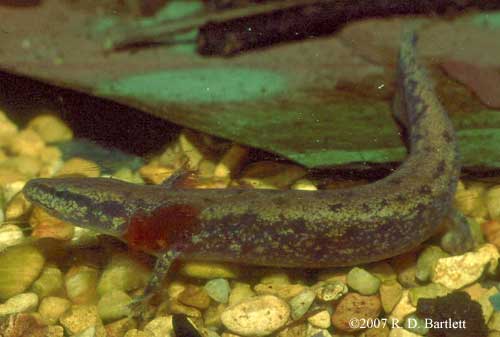| Necturus lewisi | |||||||||
| Neuse River Waterdog | |||||||||

|
|
||||||||
Description
A medium sized waterdog with a rusty ground color and large spots on the dorsal and ventral surfaces. Similar to N. maculosus, but the spots are larger and fewer in number. Like all Necturus species, this species has four toes on all feet and bright red external gills. Larvae are striped horizontally. Adults range in length from 16-28 cm (6-11 in).
Range
This species is only found in North Carolina in the Neuse and Tar River systems.
Habitat
Large streams that are greater than 15 m wide and 1 m deep seem preferred (Braswell and Ashton 1985). N. lewisi is most common on hard substrates, but is sometimes found in habitats with mud and debris. Shelters include burrows constructed by individual waterdogs or shelters previously created by other animals. Also, N. lewisi is found in the more conventional habitats of waterdogs: under rock overhangs, boulders, and slabs of rock.
Comments
Due to pollution and its restricted range, this species is near-threatened. It is also one of the more heavily researched Necturus. This species has a chemical defense that is excreted from the skin, most likely to fend off predatory fish. Courtship behavior of this species has been observed in captivity (Petranka 1998, p. 423).


References
Bartlett, R.D. and P. Bartlett 2006. Guide and Reference to the Amphibians of Eastern and Central North America (North of Mexico). University Press of Florida: Gainesville, Florida.
Bishop, S. C. 1943. Handbook of Salamanders. Comstock Publishing Company: Ithaca, NY.
Braswell, A. L., and R. E. Ashton, Jr. 1985. Distribution, ecology, and feeding habits of Necturus lewisi (Brimley). Brimleyana 10:13-35.
Petranka, J. W. 1998. Salamanders of the United States and Canada. Smithsonian Institute Press: Washington DC.
Text © 2009 Ryan St. Laurent
